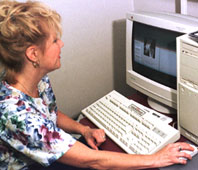FARRELL
§ § §
BMD shows early signs of bone loss
§ § §
SCAN ALSO CHARTS PROGRESS OF OSTEOPOROSIS
Herald News Editor
 David E. Dale/Herald Radiologic technician Margie Shrawder works with the computer that is connected to UPMC Horizonís DEXA scanner. With a click of the mouse, Ms. Shrawder can get the computer to calculate the density of the bone that appears on the computer monitor. |
The test the doctor may not have ordered is a BMD -- a Bone Mineral Density measurement. The test can help women -- and men -- learn whether they have strong bones or are headed toward osteoporosis.
The doctor may not have ordered a BMD because the test "is not a screening tool," said Debi Gurtner, director of imaging services for UPMC Horizonís Womancare Center.
Doctors order the scans, she said, when a patient is at high risk for the disease, to confirm a diagnosis of osteoporosis or to compare a patientís progress once she is already being treated. One reason doctors donít order routine BMDs is most health insurers will pay for them only if a patient really needs one, for instance after she breaks a hip, Ms. Gurtner explained. Although she couldnít say for sure, she thought the test carries a price tag of about $200.
BMDs are also relatively new, as is treatment for osteoporosis, said Dr. Jon Ciambotti, a radiologist. "Weíve known about osteoporosis for a long time, but we couldnít do anything about it before. Now we can treat osteoporosis and prevent further bone loss," he said, emphasizing that there is no cure, only prevention.
Among the types of bonedensity tests available is the DEXA scan. It takes less than 15 minutes, is painless -- the scanner never touches the body, and preserves patientsí dignity -- they get to leave their clothes on!
The Dual Energy X-ray Absorption Unit, which for now is housed in UPMC Horizonís hospital in Farrell, looks like a mechanical arm over a table, coupled with a computer terminal.
The patientís vital statistics --- sex, age, weight and ethnic background -- are keyed into the computer. Then the patient lies flat on the table while the arm slowly moves over her torso, emitting a very low-level X-ray. The DEXA unit emits a tenth the radiation of a regular X-ray so thereís no need for protective walls or other gear, said radiologic technician Margie Shrawder.
As the DEXA unit moves, an X-ray slowly grows on the computer monitor in much the same way that a photo being scanned into a home computer appears on its monitor. "If there were holes in the bone, I could see it on the screen," Ms. Shrawder said.
A common DEXA scan involves two X-rays: one of the lower spine and the other of the hip, although the test can be done on a wrist or forearm, she said.
Once the scanning is done, the computer goes to work, checking for changes in density and calculating air, fat and bone to determine two scales. The T scale compares the patientís bone density with that of a 20-year-old woman, whose bones would be at their strongest. The Z scale compares the patientís bones with those of other people of the same age and ethnic background, Ciambotti explained.
The computer prints the patientís numbers and a graph showing how much the numbers vary from what the World Health Organization has determined is normal, Ciambotti said. A number too far below normal signals osteoporosis.
Armed with that information, doctor and patient can decide the best treatment -- usually estrogen replacement or one of the new drugs, like Fosamax or Evista; a diet rich in calcium and vitamin D; weight-bearing exercise, which is just about anything except swimming; and education.
The scan also helps monitor the progress of patients already being treated for osteoporosis, Ciambotti said. By comparing a patientís numbers from one year to the next, a physician can determine whether the treatment plan is working or if it needs adjustment, he said.